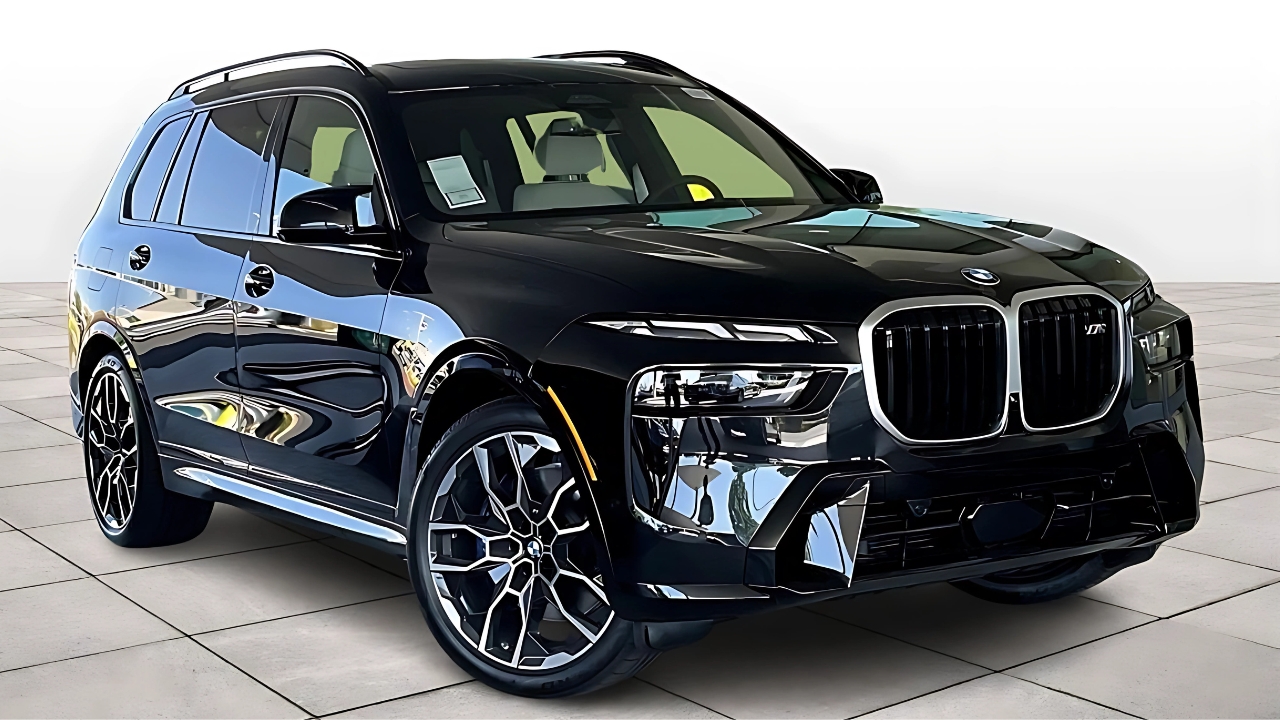When you first glimpse BMW’s latest X7 rolling down the street, something immediately feels different. This isn’t just another luxury SUV trying to blend into the background – it’s making a statement that stops conversations mid-sentence. BMW has just introduced something the automotive world hasn’t seen before on their flagship SUV: a striking two-tone paint option paired with authentic Japanese interior artistry that transforms the cabin into something closer to a mobile art gallery.
A Bold New Visual Language
The two-tone paint treatment represents BMW’s first venture into dual-color schemes for the X7, marking a significant departure from traditional single-color luxury vehicles. This isn’t simply slapping two colors together and hoping for the best. BMW’s approach involves a meticulous hand-applied coach line that creates a precise visual separation between the upper and lower body sections.
Picture this: Storm Bay metallic meeting Frozen Dark Grey, with that thin, perfectly straight line dividing them like a horizon at sunset. The lower body panels – doors, fenders, and bumpers – receive the first color application. After proper curing, skilled technicians mask specific areas with surgical precision before applying the contrasting shade to the roof, pillars, and upper door frames.
The process demands patience and expertise. Each vehicle spends additional time in the paint booth, where craftspeople ensure the coach line runs true from front to rear. This attention to detail explains why the two-tone option adds approximately $8,000 to the standard paint costs, but for owners seeking distinction, the investment transforms their 5,400-pound SUV into something that announces their refusal to disappear into traffic.
Japanese Artistry Meets German Engineering
Inside the cabin, BMW has taken an even bolder step by introducing twelve traditional Japanese patterns that can be applied across the dashboard, center console, and door panels. This collaboration with Kawashima Selkon Textiles, a Kyoto-based fabric maker established in 1843, brings centuries-old design philosophies into modern automotive luxury.
The patterns range from geometric cherry blossom motifs that capture spring’s fleeting beauty to abstract wave designs that evoke the rhythm of ocean tides. Each design gets scaled appropriately for the X7’s generous cabin dimensions, ensuring the patterns flow naturally rather than appearing forced or out of place.
Installation begins with precise measurement and cutting of specialized foil materials to match each interior surface. The dashboard receives the most prominent pattern placement, extending from the instrument cluster housing to the passenger side trim panels. Door panels feature coordinated designs that create visual continuity throughout the cabin, while the center console treatment includes pattern elements that complement the gear selector surround and cup holder areas.
Even the door handle recesses receive decorative touches that tie into the overall design theme. This comprehensive approach ensures the Japanese influence appears integrated rather than applied as an afterthought. The result transforms the typical luxury SUV interior into something that feels more like a carefully curated living space.
The Art of Personalization
What makes this offering particularly compelling is how it challenges conventional luxury vehicle thinking. Traditional luxury often meant restraint – tasteful colors, subtle materials, designs that wouldn’t offend anyone. BMW’s new approach acknowledges that today’s luxury buyers want their vehicles to reflect their personality rather than conform to someone else’s idea of good taste.
The Japanese interior patterns add between $6,000 and $12,000 to the vehicle’s price, depending on complexity and coverage area. While this might seem steep, consider what you’re actually purchasing: hand-applied artistry that transforms your daily commute into an experience surrounded by designs that have cultural significance spanning generations.
BMW provides detailed care instructions for maintaining both the exterior paint and interior patterns. The two-tone finish requires careful attention during washing to avoid damage to the coach line, while the interior patterns need specific cleaning protocols to preserve their appearance over time.
Global Appeal, Limited Availability
Currently, this distinctive X7 configuration is available primarily in Japan, where BMW initially tested market response with the Nishiki Lounge concept. Strong customer interest prompted the company to offer these options for sale, though production remains limited and exclusive.
The exclusivity isn’t just marketing – it’s practical. Each customized X7 requires dedicated build slots that allow craftspeople to complete the specialized work without rushing. This typically adds four to six weeks to standard delivery times, but the wait ensures proper attention to detail.
BMW’s selective rollout targets markets where automotive individualism thrives. American buyers who park their vehicles in country club driveways, German enthusiasts who understand the difference between transportation and expression, and Asian customers who view their vehicles as extensions of personal success stories represent the core audience for these distinctive options.
Technology Meets Tradition
Beyond the visual drama, the X7 continues delivering the technological sophistication BMW owners expect. The curved dashboard display combines a 12.3-inch digital instrument cluster with a 14.9-inch central touchscreen, all powered by BMW Operating System 8.5. Wireless Apple CarPlay and Android Auto connectivity, along with the BMW Intelligent Personal Assistant, ensure the high-tech experience matches the artistic interior treatments.
The vehicle’s performance capabilities remain unchanged. The base 3.0-liter inline-six engine produces 375 horsepower with mild-hybrid technology, while available V8 options deliver up to 523 horsepower. Standard all-wheel drive and adaptive air suspension ensure the X7 drives as impressively as it looks.
The Future of Automotive Expression
This new X7 represents something larger than just paint and interior options – it signals a shift toward vehicles as personal expression platforms. Rather than offering endless variations of black, white, and silver with beige or black interiors, BMW acknowledges that luxury buyers want their vehicles to tell their story.
Whether BMW expands these options beyond Japan remains to be seen, but the strong initial response suggests growing appetite for automotive personalization that goes beyond traditional luxury vehicle parameters. For buyers seeking a vehicle that starts conversations rather than blending into parking lots, the two-tone X7 with Japanese interior artistry offers something genuinely unique in today’s luxury SUV landscape.
ALSO READ: 2026 Suzuki Jimny Three-Door Prepares for Aussie Re-Launch with Safety Boost
